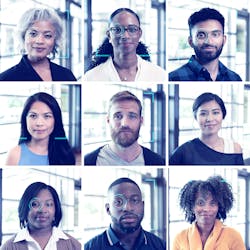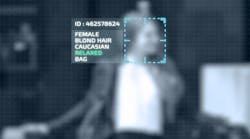Unique web-based facial recognition tool enhances security and fights crime
Law & Order, the longest-running law-enforcement series in American television history, airing from 1990 to 2010, opened with the qualifier: “In the criminal justice system, the people are represented by two separate yet equally important groups: the police, who investigate crime; and the district attorneys, who prosecute the offenders. These are their stories.” When it comes to law and order and facial recognition, there are also two important groups; law enforcement agencies who investigate crime and the technology they use to help prosecute the offenders.
However, in the case of Clearview AI, the distinction between what facial recognition is and how it is used by law enforcement agencies and other security organizations may not be what it seems in the traditional conception of facial recognition applications. That’s because Clearview AI is not a facial recognition surveillance tool, but rather an investigative intelligence platform that helps to expedite criminal investigations by employing comprehensive reporting capabilities and strict administrative oversights that help eliminate privacy abuses and police overreach.
What It Is and Does
Clearview compares itself to Google Images searches. This unique web-based intelligence platform is powered by facial recognition technology that includes the largest known database of more than 20 billion facial images sourced from public-only web sources, including news media, mugshot websites, public social media, and other open-sourced websites such as Flickr, Instagram and Getty Images, where captions or other details reveal more about subjects. The technology solution allows agencies to gain intelligence and disrupt crime by revealing leads, insights and relationships to help investigators solve both simple and complex crimes and increase officer and public safety.Clearview says that its database is the most representative of the population and is not limited to criminal offenders (mugshot database). With over 20 billion publicly available images, the database covers a multitude of ages, ethnicities and physical characteristics. Also, it provides images that would not be available through other searchable engines and can identify those without an alias presence, without a prior arrest record or DMV record, or other potential suspects that would often remain unidentified.
As co-founder and CEO Hoan Ton-That and his team roll out several technology upgrades at this week’s ISC West event in Las Vegas, he is anxious to explain to new potential clients what makes the Clearview AI concept different from the ubiquitous and controversial facial recognition paradigm.
“We're a facial recognition search engine – not a surveillance tool. That search is publicly available online information online -- it's like a Google for faces. Presently it is being used by law enforcement agencies around the United States to solve crimes in an after-the-fact manner. This is not in a camera in real-time,” says Ton-That, explaining that if a crime has been committed and the suspect can’t be identified by the victim, but you have a description or a photo, authorities can put the image through the Clearview search engine, like doing a Google search. “You then start your investigation, click those links and try and identify who (the suspect) is. It is being used very successfully by 3,100 agencies around the U.S. including the FBI, Homeland Security and local agencies. It has been very successful in solving crimes against children, homicide cases, financial fraud, and even victim identification, especially after arresting a pedophile or a child molester.”
One of the selling points that has increased the credibility of the Clearview solution, especially with public safety and law enforcement, is the fact that of the billions of mug photos that are currently accessible its algorithms enable the users to have a nearly 99% accuracy rate in the searchable-engine platform compared to a 70% accuracy rate with traditional facial recognition surveillance tools. Clients can also import their own private, customized facial datasets such as mugshot repositories or watchlists.
According to a recent Reuters report, Clearview uses AI to apply masks, glasses and other distortions to training images, enabling it to recognize faces when obscured, in profile, deep in the background or 20 years younger. In turn, Clearview had greater accuracy than rival tools, according to a U.S. government (NIST) evaluation last year.
Ton-That is touting a 2.0 release of the Clearview AI solution this week at ISC West that includes the increase to 20 billion images in the database and other software-user upgrades.“A lot of the features in this Clearview 2.0 release, which is what we're calling it, are about getting that hit rate to be higher. We also have a new image enhancement tool that allows investigators to go in and crop, rotate and flip images. And we have some additional AI dealing with lightning images that are very dark and de-blurring them as well. These (modifications) have shown success in practice without early beta testers, so we actually have results in real cases. It’s quite phenomenal to see some of these (software upgrades) actually result in positive outcomes in the higher-end cases,” Ton-That admits.
“We have also added a new investigative workflow process that enables us to help the administrators and everyone in the agency track a case from start to finish. We were the first in the industry to roll out an intake form and that's really important for the compliance issues. What that means is before a search is done, you can put in a case number and a crime type so that our customers can make sure that it's being used for the right purpose. “
Ton-That says his company ensures an orderly process for agencies to follow when opening and pursuing their own investigations.
“When a client gets their Clearview AI account as an investigator, we make sure that every agency is approved to use it even for a trial purpose and they have an administrator on board. Before you begin an investigation, you put in a case number, a crime type and what type of investigation it is. Then you can start doing searches which take under a second,” he says. “What we have that's proprietary to us is one of the most accurate algorithms in the world. In fact, it’s the most accurate in the Western world, according to NIST. The platform is excellent across mugshot photos, visa photos and border photos as well.”
True Crime Stories from the Clearview AI Files
Miami Police Department: In August of 2021, Miami PD used Clearview AI to help solve a murder and an attempted murder in two separate crimes. Two customers went into a gas station and got in an altercation with the clerk over not wearing a facial covering. One of the customers fired several shots at the clerk and fled the scene. The Miami (Florida) Police Department was attempting to identify the suspect and the accomplice who drove the suspect away from the scene. At the same time, a neighboring police department was trying to solve a murder that occurred shortly after the gas station shooting. The two police departments were working independently, unaware of a significant link between the two crimes.
Miami PD had released a “need to identify” request connected to the gas station shooting, but neighboring agencies receive many such requests. Miami PD has access to the Clearview AI software. This was one of approximately 300 investigative uses of Clearview AI by Miami PD in 2020, including both local cases and a request for assistance in identifying persons who breached the security perimeter at the U.S. Capitol on January 6.
A Clearview AI search conducted by Miami PD instantly returned a top potential match for the gas station shooters’ accomplice via a prior arrest record. Further investigation linked this crime to the neighboring jurisdiction’s murder, in which the accomplice was murdered. Ballistics evidence established that the same gun was used in both crimes, which occurred within an hour of each other, therefore suggesting that the gas station shooter subsequently shot and killed his accomplice.
After additional investigative work, Miami PD obtained an arrest warrant for attempted murder. When the suspect was caught out of state, he was extradited back to Miami on both charges as a result of using Clearview AI and solid investigative work by Miami PD.
Helping the Feds in an international drug bust in May 2021: A federal law enforcement agency’s intelligence project had hit a dead end. A coordinated criminal organization based in Mexico used Facebook to recruit drivers to cross the United States/Mexico border to deliver money. The network secretly placed illegal drugs into the drivers’ vehicles and warned them that they were being tracked with the supposed money they were carrying. Unaware that they were now smuggling drugs, some of the unwitting mules were later caught smuggling the narcotics into the U.S. from Mexico. Law enforcement tried to identify the recruiter just based upon the nickname the unwitting mules provided, but despite searching over 50 relevant intelligence databases for over a year, law enforcement could not identify the recruiter.
One day law enforcement stopped a drug smuggler crossing into El Paso, and the recruit showed the officer the Facebook page that recruited them. This page had the recruiter’s nickname along with their profile photo. A criminal analyst ran the Facebook page picture through Clearview AI and received results instantly. One result led the investigator to a photo of the suspect with their real name at a local country club, situated less than two miles from the Mexico/U.S. Border. Now that the criminal analyst had identified his target, he used other investigative methods to determine their sub-recruiters, prior perpetrators, and prior drug seizures tied to the recruiter.
Clearview AI helped expedite the investigation and capture with a single search providing the pivotal lead to develop the investigation, saving hours of investigative work, solving a year-long case, and busting the members of an international drug smuggling network.
Ukraine Now Using Clearview As War With Russian Rages
Another announcement from Ton-That came last week occurred when his company offered its facial recognition search engine technology to the Ukrainian defense ministry to help uncover Russian assailants, combat misinformation and identify the dead. Ukraine is being provided Clearview at no charge to help authorities better vet people of interest at checkpoints and for other military and security challenges. The Ukrainian intelligence officials and military will have access to two billion images from the Russian social media service Vkontakte based in Saint Petersburg, out of a database of over 20 billion photos total. Ton-That also says that the software can aid in Ukraine government officials in trying to match dead and wounded civilians and soldiers with fingerprints and even those with facial damage.According to Clearview advisory board member and former U.S. ambassador Lee Wolosky, who has served under four U.S. Presidents in senior legal and national security positions, Clearview’s technology could be used to reunite refugees separated from their families, identify Russian operatives and help the government debunk false social media posts related to the war.
“Fundamentally, facial recognition technology is a safety and security technology, that's what it really is. So, in the war zone, some of the most dangerous things are not knowing who you're dealing with on either side. In order to reduce that risk, it can be a very powerful tool. Our database happens to have billions of photos from the Russian social media site, and in testing our solution the Ukrainians have been able to identify people and see their profiles on social media, say, in a Russian military uniform,” Ton-That explains.
“So, there could be an identification of people who have committed war crimes, as well as the humanitarian cases. What if someone doesn't have identification with them and they're in a refugee area and they can't get out? This can help speed up that process where now they have some idea of who they're taking in. I think it's, overall, going to be something very positive. If we could help save one life or make the situation less tense, that's going to be a really great honor for us.”
About the Author: Steve Lasky is a 34-year veteran of the security industry and an award-winning journalist. He is the editorial director of the Endeavor Business Media Security Group, which includes magazines Security Technology Executive, Security Business and Locksmith Ledger International and top-rated webportal SecurityInfoWatch.com. Steve can be reached at [email protected].









